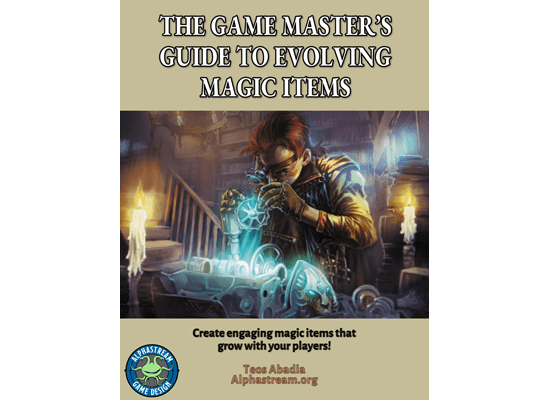Your Game’s Lore? Make it Actionable!
Our books, especially those from older editions, are full of lore. DMs typically enjoy reading lore, but are also intimidated by lore. We ideally want to enable DMs to easily portray a rich world. One solution is actionable lore.
Before We Get Started…
Both the Intro and first episode of my new show, Success in RPGs, is out! Please take a look if you haven’t already. And, if you like the show, please help spread the word! A share on your social media platform of choice goes a long way towards helping the show. Thanks!
Now for actionable lore…
Lore is a Catch-22
Remember how we discussed that D&D wants to not have a timeline, but also wants to have adventures link back to past events? Similarly, D&D wants to create a rich world but not define so much that lore and canon become cumbersome. It’s very hard to achieve that.
This all started with a conversation with Enrique Bertran and Keith Ammann on Twitter:
I butted in with the following:
Here’s what I mean. Sourcebooks, particularly from older editions, tend to have dense historical lore. At the heart of all the lore is an interesting topic, such as the history of the ring of winter artifact, how the Cult of the Dragon came to be, or how Candlekeep functions. We want to use this in our game, but the material is encyclopedic. A DM can feel as if they are back in school, studying for an exam. Worse still, they may worry that a player at their table will know the material better than they do!
This problem is even greater for designers. As a freelancer, I talked about how Shawn Merwin and I began researching the lore of Candlekeep for Confrontation at Candlekeep. It was really intimidating at the beginning. There were several novels that visit Candlekeep! A video game! And many sourcebooks and boxed sets. What to do?
A Lot of Existing Lore is Empty Words
What was super interesting is that there was actually very little lore that was relevant to creating a Candlekeep adventure. The novels I read? The novels told me Candlekeep has nondescript rooms with books in them. (Thanks, novels.) The sourcebooks had some useful lore, and the video games had maps, but it was still surprisingly little and at times contradictory. Most of the lore was encyclopedic and unlikely to ever impact the players and their characters.
Here is an example:
There is a 5E adventure where, in the middle of the wilderness, we can run into Artus Cimber and his saurial companion. Artus is featured in novels and carries the potentially world-changing ring of winter artifact. We are told he is unlikely to trust the party or tell them who he is, what he is doing, or about his artifact. His appearance ties into an earlier adventure, but due to the levels of play the same characters won’t have played it, and the structure of that adventure means there is only a small chance the players actually dealt with that storyline. There is a lot of design work here, but it doesn’t really benefit the characters.
So, what can we do?
Actionable Lore
When you add lore, whether it be for your home campaign or as a designer, think through the purpose of that lore. If you are writing a section that needs to be encyclopedic… say, the history of the Cult of the Dragon… so be it.
If the lore is at all intended to help play, or is something the DM should use in their game, then it needs to be actionable. (And, even if you are purposefully writing encyclopedic lore, I would argue you should add a section that is actionable.)
Actionable lore comes with instruction for the DM on how to use it. Consider these two examples:
- The Cult of the Dragon once believed that ancient texts prophesize that dragons should be turned to dracoliches, but now a growing faction believes the key is to gain the help of living dragons. This faction is in the PCs’ area, seeking to win the favor of a green dragon.
- The PCs learn that the Cult of the Dragon is active in a nearby forest. Venturing into the forest, a Harper agent can reveal that there are two different groups of cultists, each trying to find the dragon lair before the other. The stronger of the two groups seeks to win over the dragon as an ally, while the weaker faction seeks to convince it to embrace undeath.
The two paragraphs are very similar. In the first, the lore happened in the past, and if the characters hear about it, it may be interesting. But it is unlikely to be actionable.
In the second example, the lore is active and actionable. There are two groups, and the characters might investigate and attack both, pit one against the other, or ally with one. The lore becomes a key factor in how play will develop. Some groups might even try to get to the dragon first, and convince it that neither faction is worth following!
Guidelines for Actionable Lore
Here are some guidelines for actionable lore:
- What value will the lore provide at the table, during play?
- In what situations will this lore come up? How will the DM bring this to the table? If there are too few triggers, retool the actionable elements.
- How will the players use it? We want lore to be important and useful and for the players to feel good when they act upon it.
- Can the lore be used now? Ancient lore can be interesting, but it’s stronger if it is useful right now, in this scene or an upcoming scene.
- Is it the right amount of lore? Lore is ideally bite-sized. We want to be able to understand it fully and act upon it, and only then learn the next part of the lore. Too much lore means lower retention and lower impact to the players.
- Is it going to be interesting? If you know the players, and the characters, or even the expected type of players/characters, tailor the lore to their interests.
- Does it further the theme? Lore can further the campaign’s theme, from political intrigue (the council member’s secret) to horror (the terrible thing the town did) to high fantasy (the location of the holy sword).
What do you think? What sourcebooks and adventures have handled lore well? How do you help lore resonate in your campaigns or your design?

Or, pick it up on DriveThru RPG!







 Mastodon
Mastodon BlueSky
BlueSky
I really like this article, and it makes a lot of sense. As DM’s, it seems like we could run better adventures that have lore by taking the approach when we prep a session to make some of the lore actionable as well. If you are running homebrew in your own world, then obviously you are the only one that can do this – but even if we are running a campaign that is pre-written, there is no reason not to take 5 minutes to review and make certain things actionable. You’re example above could apply really well to the Dragon Cultists in LMOP for example in Thundertree – as they are written, they are just there kind of waiting to be dealt with. Great suggestion!
I’d love that map of the Forgotten Realms that NewbieDM mentions…but on topic I think Dragon Heist dealt with the recent lore of Waterdeep and Tyranny of Dragons pretty well. My players got the gist and we’re invested in it.
Came here from the Mastering Dungeons podcast, and really appreciate you bringing this up during a recent episode. This is so important, and one of the reasons I really dig Eberron. More than any other campaign setting, it seems like it was built from the ground up with this philosophy that lore doesn’t mean anything unless solid, tangible examples of how it impacts the current adventure are provided.